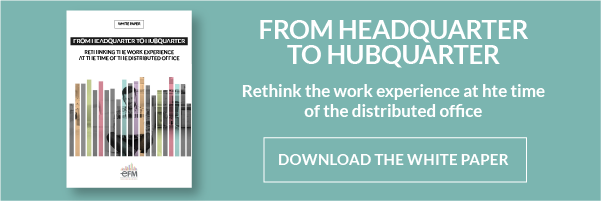Workplace management: 3 ways to improve your office
What are the objectives of the workplace management? From a higher perspective, we can say its about optimizing the balance between productivity and costs of the workplace. As for the first aspect, several studies clearly relate employee engagement with individual productivity, motivation and turnover, thus closely linking it to the company's results. But what does the office have to do with all this? Despite the concepts of smart working and "distributed work" are gaining traction, the office will still be a key element of the company ecosystem for a long time: perhaps it will no longer be the place where you go every day, but it will certainly be the one where you feel the company culture the most, create new bonds and have high level of interaction; the office will always be the synthesis of the company’s history, values and mission.
That is why the physical space still has a role and an impact on the engagement, and this is influenced by the space design, the services offered, the integrated technology and the organization: these considerations can be seen as trivial, but how engaging can an open space be, where twenty people talk to each other or are always on the phone, constantly disrupting your concentration? Or even a meeting room where the air conditioning is out of order for days or is always busy? Often the factors that affect the engagement – and therefore the company's results – are much more nuanced than these, and therefore also more difficult to grasp: a meeting room that cannot be booked can be one of these, but also a layout that prevents random interactions between people, some areas of the building with excessive temperature or humidity, and so on.
Workplace management: the meaning of a sensible place
From the workplace management point of view, it makes a lot of sense to introduce the concept of the "sensible place", a sentient place which metaphorically listens to the people who live there, catches any signs of dissatisfaction and enables you to make decisions aimed at maximizing engagement. Of course, these decisions do not necessarily force the company to restructure the space layout or to replace technologies: sometimes it takes little to improve engagement, you just need the right data to work on. Thanks to a series of technological tools, a sensible place is able to acquire and process data in real time – both environmental and social – that have great impact on the way people enjoy the work experience, in order to improve it through a better workplace management
Workplace management and costs
Earlier we were talking about costs. A sensible place also has a major impact on this aspect, simply because optimization goes together with a strong reduction of inefficiencies. If you have data of what happens in the office, the way in which spaces and services are used, the people’s journey, you can identify poorly used and ineffective services, or unused spaces that were affecting costs but could be dedicated to profitable activities. Wokplace management is about giving a broad view on what is happening inside theoffice, and also enabling you to use this data and effectively react to the information that the sensible place provides you with on a daily basis.
The role of IoT and data in workplace management
Regarding workplace management once again, we can ask ourselves what are the tools that help us transform a traditional work environment into a sensible place? There are several of them, but we can group them into three large areas:
Workplace management and IoT
Without data to work with, it's impossible to even talk about sensible place. Luckily, nowadays sensors and IoT devices are widespread and enable you to acquire useful information for the work experience optimization. They range from common humidity and temperature sensors to the measurement of sound pressure, up to technologically advanced systems able to understand the feeling of people, thanks to Computer Vision techniques, or just to track movements, accompany them inside buildings with indoor navigation systems, communicate through customizable messages sent via app and so on. In short, from the daily life that takes pace in an office it is possible to gather a wealth of information regarding spaces, services and more broadly, how work experiences are carried out.
Feedback from workplace management
Recording data and understanding emotions are two different things. It has already been said that current computer vision techniques enable you to capture the sentiment, but nothing can replace ––traditional feedback, also because of a matter of immediacy. Therefore, it is crucial that a sensible place is not limited to acquiring data, but more importantly it should dialogue with the user to understand how much it has been able to meet the person’s needs: to give an example, a space reservation system can ask users their feedback about the quality of experience and propose another workstation with different characteristics (position, orientation, average temperature, acoustic level, etc.) the next time, in case of a negative review.
Raw data is not enough for workplace management
Talking about this topic, it is easy to jump straight to artificial intelligence, but it is true that raw data are of little use. What matters is the underlying information, which is essential for decision making and to automate office management. An IT platform clearly cannot decide to rethink the layout of the office (at most, it can suggest it can give a suggestion), but at the same time it can autonomously manage the allocation of workstations, trying to satisfy - and anticipate – people’s needs. Therefore, the main point is to move from feedback to feedforward, that is collecting data to suggest the users the best way to enjoy the moments that compose their work experience.




